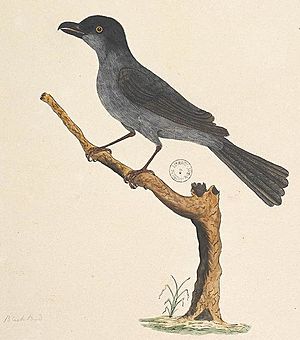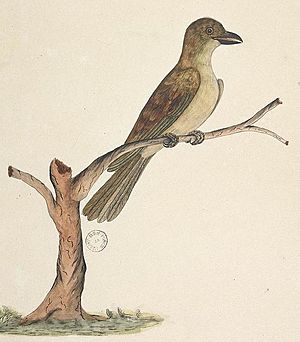Norfolk starling facts for kids
The Norfolk starling (Aplonis fusca fusca) was a small bird that belonged to the starling family. It is now extinct, meaning it no longer exists. This bird was a type of Tasman starling, and its only close relative, the Lord Howe starling, is also extinct.
Quick facts for kids Norfolk starling |
|
|---|---|
 |
|
| Norfolk Island Tasman starling (Aplonis fusca fusca), from the collection Drawings of birds chiefly from Australia, (1791-1792) | |
| Conservation status | |
| Scientific classification |
|
| Kingdom: | Animalia |
| Phylum: | Chordata |
| Class: | Aves |
| Order: | Passeriformes |
| Family: | Sturnidae |
| Genus: | Aplonis |
| Species: | |
| Subspecies: |
†A. f. fusca
|
| Trinomial name | |
| Aplonis fusca fusca (Gould, 1836)
|
|
Where the Norfolk Starling Lived
The Norfolk starling lived only on Norfolk Island. This island is an Australian territory. It is located in the Tasman Sea, between Australia and New Zealand.
What the Norfolk Starling Looked Like
The Norfolk starling was about 20 cm (8 inches) long. Its wings were about 9.8 to 10.3 cm long. The tail measured 6.3 to 6.8 cm. Its beak (culmen) was 1.3 cm, and its legs (tarsus) were 2.5 cm.
These birds were mostly greyish-brown. Male Norfolk starlings had shiny metallic green feathers on their heads and throats. Their backs, rumps, and wing feathers were grey. Their undersides were also grey, but the feathers under their tails were whitish.
The male's beak was black, and its eyes were orange-red. Female starlings looked similar to males. However, their green feathers were a bit duller. Their grey throats stood out against pale brownish sides. The lower part of their chest was yellowish-brown. Their belly and the feathers under their tail were yellowish-white.
Why the Norfolk Starling Disappeared
The exact reasons why the Norfolk starling became extinct are not fully clear. Several things might have caused its disappearance.
One reason could be competition from other birds. Birds like the European starling, song thrushes, and common blackbird were brought to Norfolk Island. These new birds might have competed with the Norfolk starling for food and places to live.
Another possible reason is too much hunting. People might have hunted these birds too often. Also, their habitat (the natural place where they lived) was lost. Forests were cleared for farming, which took away the birds' homes.
Some older stories said that rats caused the extinction of the Norfolk starling. However, this is not correct for this bird. Rats did not become a big problem on Norfolk Island until around 1940. The Norfolk starling had already become extinct in 1923, long before the rats arrived.



